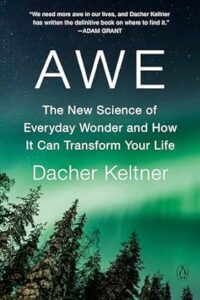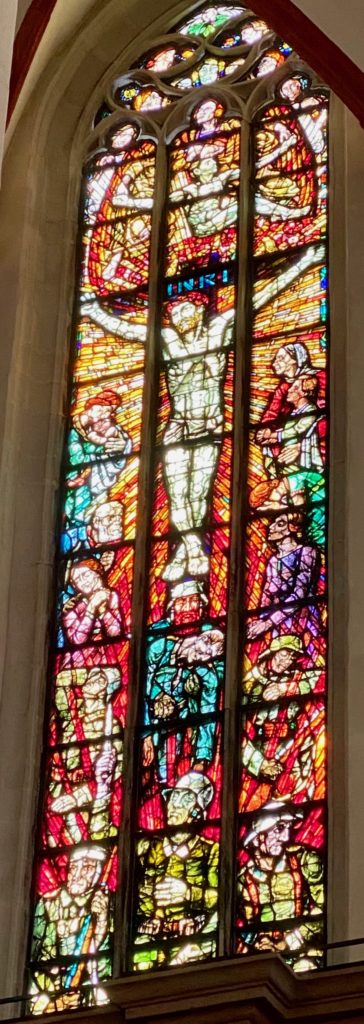Feeling Awe
 AWE: the New Science of Everyday Wonder by Dachar Keltner. is the book I bought after meeting a woman on our plane from Florida to Arkansas. Her backpack was embroidered “National Gallery of Art,” so I just had to tell her how much I have enjoyed that wonderful institution over the last 56 years. A curator, she was carrying that book on her way to Crystal Bridges, the Museum of American Art founded by Alice Walton, daughter of Walmart founder Sam Walton. The museum, designed by architect Moshe Safdie, opened with great fanfare in November 2011. Marjo and I got to see it when we visited Steve’s cousin Roger Collins in April 2014. Now, sadly, we were on our way to Roger’s funeral.
AWE: the New Science of Everyday Wonder by Dachar Keltner. is the book I bought after meeting a woman on our plane from Florida to Arkansas. Her backpack was embroidered “National Gallery of Art,” so I just had to tell her how much I have enjoyed that wonderful institution over the last 56 years. A curator, she was carrying that book on her way to Crystal Bridges, the Museum of American Art founded by Alice Walton, daughter of Walmart founder Sam Walton. The museum, designed by architect Moshe Safdie, opened with great fanfare in November 2011. Marjo and I got to see it when we visited Steve’s cousin Roger Collins in April 2014. Now, sadly, we were on our way to Roger’s funeral.
The concept of Awe stayed with me as we reunited with daughter Shelby and grandson Stephen, who had driven up from Austin, and many close cousins, all drawn together by our love for Roger. The funeral was on July 9 at a large church in Springdale, Arkansas; at least 500 people attended. Roger’s brother Jay and his daughters, Lauren and Lindsey, spoke of his bountiful love for his family and his community. Several people whom he had mentored when he was CEO of Harps Food, a large regional grocery chain, gave heartfelt tributes. We had always known Roger as a man of sterling character, who drew the best from others with his adroit sense of humor. After reading Awe, I understand better why he was so beloved. Moral beauty is the first of the 8 sources of Awe that Keltner describes.
- Moral beauty – outstanding goodness and courage
- Collective effervescence – weddings, funerals, sports celebrations, political rallies
- Nature – walking through forests, running in sand dunes, seeing the ocean
- Music – concerts, listening quietly, singing or playing with others
- Visual Design – buildings, dams, paintings, sculpture
- Spiritual and Religious – finding a connection with the Divine; mystical awe
- Life and death – childbirth, death of a loved one
- Epiphanies – sudden understandings of essential truths about life
Just ten days later, as I read Awe on three long flights from Florida to Scotland, I took a break to watch a recent documentary. Lift is a movie about a New York City Ballet dancer who had grown up in a homeless shelter in the Bronx. Over the last decade he has reached out to kids in shelters and helped them develop their talent for dancing. When people move together in unison, says Keltner, they can experience collective effervescence, the second source of awe. In the concluding scene of the movie children and their parents do just that, which brought copious tears to my eyes.
The book gives other examples, such as marching bands and fans doing waves at sporting evens or concert–have you ever participated in such a movement that brought you awe?
When I told my Bible Study friends about Keltner’s AWE, my friend Barbara Walton wrote me right away about how she had experienced awe in Nature:
Thank you for introducing me to the book, Awe. It brought to mind a day when I was young and saw a beautiful field of wild violets in the woods. The beauty was so overwhelming that I sat down in wonder. Now you have put a name to what I felt that day. It was more than just a passing feeling. It was Awe! It has stayed with me always and I’m now 91. A painting I did of violets long ago still hangs on my wall.
Violets are special to me, too. Violet, an anagram of “to live,” is the name of my first granddaughter. I also remember feeling awe of nature on a grander scale when Steve and I visited Yosemite National Park with his sister Karen and Joe, just weeks before her sudden death in 2014.
Music has always been my primary source of awe, such as the symphony concert I heard in an open-air theater at the Alhambra on June 16. On July 26, a visitor to the Cathedral here in Dornoch, came to me at the piano and told me that she just had to thank me.
This place is so beautiful. I looked at all the stained glass windows and sat down to say a prayer. As soon as I said amen, you began playing the Moonlight Sonata by Beethoven, my favorite piece. I was overcome with joy.
I was thrilled that she shared her moment of awe with me!
In 1967, while Steve and I spent the summer in Istanbul, my parents and my brother Harry visited the World’s Fair in Montreal and saw Habitat, an earlier work by Crystal Bridges’ architect, Moshe Safdie. Their enthusiastic reports about Habitat made me more sensitive to Visual Design, the fifth source of Keltner’s concept of .Awe.

When my daughter Shelby arrived in 1978, ten days after the East Building of the National Gallery of Art opened, the Washington Mall became a place to find Awe both inside and outside I. M Pei’s marvelous design. Daughter Lilli fed my interest in visual design as she earned her Bachelor’s and Master’s degrees in Architecture in the 1990s, so I was ready to be amazed by Crystal Bridges, nestled in 120 acres of Ozark forest. Moshe Safdie’s design brings together two sources of awe: visual arts and nature.
The sixth source, Spiritual and Religious Awe, seemed to be the most difficult for Keltner to explain. I found it difficult to distinguish between a religious experience and an Epiphany, which he listed as the eight source of awe. My most vivid memory of the two together was in 2001, when my brother Joel and I took a two-week tour in the Footsteps of Bach. It concluded at the church in Leipzig, Germany, where Bach produced his some of his greatest music:
 Leipzig, 2001: A wave of emotion engulfed me that Sunday morning, tightening my throat and flooding my eyes. Suffused with the history we had been absorbing, with the joy of new friendships, and with a deeper relationship with Joel, I was primed for a special experience that morning. Three windows kept safe during WW II had captured our attention. But it was a fourth window that brought it all together, the one I couldn’t see until I went to the altar for communion.
Leipzig, 2001: A wave of emotion engulfed me that Sunday morning, tightening my throat and flooding my eyes. Suffused with the history we had been absorbing, with the joy of new friendships, and with a deeper relationship with Joel, I was primed for a special experience that morning. Three windows kept safe during WW II had captured our attention. But it was a fourth window that brought it all together, the one I couldn’t see until I went to the altar for communion.
The upper part of the window featured a pale, suffering Christ still nailed to the cross. Below Him were German soldiers in WW I helmets bearing a fallen comrade. Portraits of grieving women with their children were punctuated by jagged, angry red shards of glass conveying both the fiery, bloody horror of war, but also the redemption of Christ’s blood. As I gazed in wonder, the Choir sang David Ashley White’s lovely setting of the New Hampshire folk hymn The Apple Tree. “By faith I know, but ne’er can tell the glory which I now can see in Jesus Christ, the apple tree.” Suddenly, an epiphany–-divinity made manifest. I could comprehend Jesus and what He meant to Germans, to Americans, and to me.
Returning to our pew with Joel, I could not conceal how deeply moved I felt. He, too, began to weep, as did other friends who saw us. Words failed when I tried to tell David how beautiful his music sounded. We simply embraced. I felt surrounded with love and beauty and grateful for everything in my life that had led to this moment.

Leave a Reply